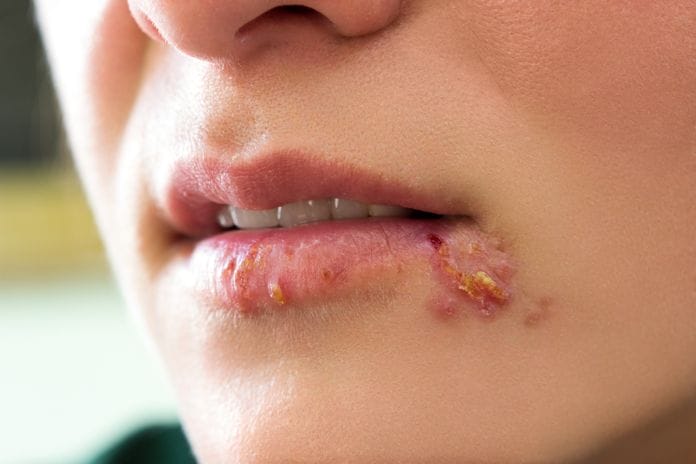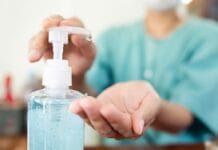As a dedicated and meticulous dental hygienist, you may find yourself noticing small details that are unnoticed or dismissed by most people. So when a patient presents for her prophy with an active herpes simplex lesion on her lip (herpes labialis), your antennae immediately go up.
As you mentally determine the best course of action to take, you calmly begin to ask the patient how long her “cold sore” has been present and how frequently they occur. As you speak with the patient, you learn that she is a new mother who is caring for her two-month-old baby.
Remember Your Education and Training
As you head to the back of the office to share the news with the dentist, you think back to your days in hygiene school when you were taught to postpone elective dental procedures if a patient presents with an active herpes lesion. When you recommend that the patient be rescheduled and that perhaps the doctor prescribe an anti-viral medication, you begin to doubt yourself when the doctor casually dismisses the lesion as “no big deal.” You begin to doubt your instincts and training and ask yourself three questions:
- “Am I properly remembering what I was taught in hygiene school?”
- “Has there been a recent change in protocol for treating patients with active herpetic lesions?”
- “Am I wrong to suggest that the patient reschedule?”
The answer to each question above is no. Elective dental treatments such as periodontal maintenance or dental prophylaxis should be postponed until the patient’s lesions have healed. The only time a patient with active herpes virus should receive dental treatment is in the case of a true emergency.
Hallmark Features of a Herpes Outbreak
While symptoms vary by person and age, the HSV-1 virus is associated with a host of symptoms that range from unpleasant to fatal. The initial outbreak of an HSV-1 infection is typically associated with a high fever, bodily lesions, headache, and malaise. Gingivostomatitis is usually present and can be particularly severe in children. Children often feel listless, lose their appetite, and may present with a dangerously high temperature (up to 104°F).1
Despite the fact that symptoms often subside within a few weeks, the herpes virus never dies. It remains within the host’s nerves for the person’s entire life and can be reactivated by illness, stress, or sunlight. The reactivation of the virus often starts with burning, pain, and itching. These symptoms are then followed by the development of pustular and ulcerating papules.1
In addition to causing pain and suffering, these symptoms can be extremely embarrassing for people with herpes. The social stigma associated with herpes can sometimes be more devastating than the physical consequences of the virus.
Why is HSV-1 so dangerous?
The high fevers experienced by people with HSV-1 can result in fatalities. HSV-1 can also infect the eye, resulting in a condition called stromal keratitis that can cause infectious blindness.2-4
Perhaps the most dangerous complication of HSV-1 is herpes simplex encephalitis. While this condition is extremely rare, it is the most prevalent cause of encephalitis in America. High rates of mortality and morbidity are unavoidable, even with anti-viral therapy. If encephalitis is left untreated, the mortality rate can approach 80% within a one to two-week timeframe.4,5
How does treating a patient with an active HSV-1 pose a threat to the patient’s baby?
Seeing an infected patient for a prophy can cause the virus to spread and result in additional lesions on the patient. Even if you are especially careful not to touch the lesion, the virus is present in saliva and can shed for three or more weeks, and there’s no way to avoid saliva during a dental appointment.1,2
HSV-1 can be fatal for infants under three months of age. A quick Google search of HSV-1 and infants reveals stories of babies who have died shortly after receiving a kiss from an infected individual. The rate of survival among infants and children who have herpes simplex encephalitis is less than 20%, even after the children receive anti-viral therapy. Children who do survive often suffer long-term effects such as seizures, developmental delays, and a 26% relapse rate.5
How does treating a patient with HSV-1 put you at risk?
The herpes simplex virus type 1 (HSV-1) is highly contagious. The virus is primarily transmitted by contact with saliva and the sores that are present during herpes labialis. There is a plethora of risks for hygienists who treat a patient with an active lesion. Some of these risks include the following:
- Exposure to the patient’s saliva is impossible to avoid when you do a prophy
- It is difficult to avoid touching the lesion even if you make every effort not to do so
- You can easily spread the virus simply by moving your gloved hand across the patient’s infected lip
- Your gloves may develop minute tears, exposing you to HSV-1 and putting you at risk7
- If you develop herpetic whitlow due to exposure to HSV-1, you could be out of work for weeks7
- You run the risk of developing ocular herpes (which can lead to blindness), even if you and the patient wear protective eyewear3,8
Dispelling the laser therapy and disinfection myths
Some dental professionals mistakenly believe that you can safely do a prophy after you treat a herpetic lesion with laser therapy. Others believe that you can prevent the virus from spreading by disinfecting surfaces that may have been exposed to the virus.
Unfortunately, there is no research that supports the efficacy of laser treatment or disinfection as a means of completely eliminating the HSV-1 virus. While laser therapy may expedite a lesion’s healing time and reduce pain associated with the lesion, there is no evidence that laser therapy will prevent the virus from spreading.9
Research has shown the ability of HSV-1 to be transmitted through slow-speed handpieces.10 The Centers for Disease Control and Prevention (CDC) indicates that dental handpieces should be heat sterilized after exposure to each patient to prevent the spread of infectious diseases.7
What is the best course of action when you encounter a patient with oral herpes?
There are many reasons to exercise caution when a patient appears with an active herpes simplex lesion. However, as a healthcare provider, you might feel conflicted about turning a patient away. Below is a summary of dos and don’ts to follow to help ensure that you follow a course of action that is the best for you and the patient.
- Do not second guess your hygiene education or brush off an active herpes lesion
- Do educate the patient about how HSV-1 poses risks to both the patient and her baby
- Do not decide to “risk it” and proceed with elective treatment
- Do reschedule the patient and use your spare time to sharpen instruments, help out in sterilization, stock operatories, or help other team members
- Don’t succumb to pressure to treat a patient you know has an active herpetic lesion
- Do educate your doctor of the many risks associated with treating a patient with an active virus
The Bottom Line
There are many risks associated with the treatment of patients with herpes. Deciding to treat a patient with herpes can have devastating consequences for a hygienist, the patient, and the patient’s children. Because the virus can survive for hours on plastic, clothing, and other surfaces, you run the risk of exposing your colleagues and other patients to the virus when they handle pens, magazines, and other items that were handled by a patient with an active virus. If you find yourself second-guessing your training, simply ask yourself if it is worth it to put so many people at risk simply to complete one elective procedure.
NEXT: 5 Infection Control Mistakes You Might Not Realize You’re Making
References
1) Salvaggio, M.R. (2021, May 24). Herpes Simplex Clinical Presentation. Medscape. http://emedicine.medscape.com/article/218580-clinical
2) Farooq, A.V., Shukla, D. Herpes Simplex Epithelial and Stromal Keratitis: An Epidemiologic Update. Survey of Ophthalmology. 2012; 57(5): 448-462. http://www.ncbi.nlm.nih.gov/pubmed/22542912
3) Hill, J., Slonim, C. (2019, March 4). Eye Herpes (Ocular Herpes). http://www.allaboutvision.com/conditions/ocular-herpes.htm
4) Baron, S. (Ed.). (1996). Herpesviruses. In R.J. Whitley (Ed.), Medical Microbiology (4th ed.). Univ of Texas Medical Branch. www.ncbi.nlm.nih.gov/books/NBK8157/
5) Anderson, W.E. (2021, June 3). Herpes Simplex Encephalitis. Medscape. http://emedicine.medscape.com/article/1165183-overview#a5
6) Herpes Simplex Virus. (n.d.). American Skin Association. http://www.americanskin.org/resource/herpes.php
7) Kohn, W.G., Collins, A.S., Cleveland, J.L., et al. Guidelines for Infection Control in Dental Health-Care Settings – 2003 [MMWR Report No. 17]. Centers for Disease Control and Prevention. 2003; 52: No. RR-17. http://www.cdc.gov/mmwr/PDF/rr/rr5217.pdf
8) Browning, W.D., McCarthy, J.P. A Case Series: Herpes Simplex Virus as an Occupational Hazard. Journal of Esthetic and Restorative Dentistry. 2012; 24(1): 61-66. http://www.ncbi.nlm.nih.gov/pmc/articles/PMC3437498/
9) De Paula, E.C., Aranha, A.C., Simoes, A., et. al. Laser Treatment of Recurrent Herpes Labialis: A Literature Review. Lasers in Medical Science. 2013; (4): 1517-1529. http://www.ncbi.nlm.nih.gov/pubmed/23584730
10) McCarthy, G.M. Risk of Transmission of Viruses in the Dental Office. J Can Dent Assoc. 2000; 66: 554-555, 557. https://www.cda-adc.ca/jcda/vol-66/issue-10/554.pdf












